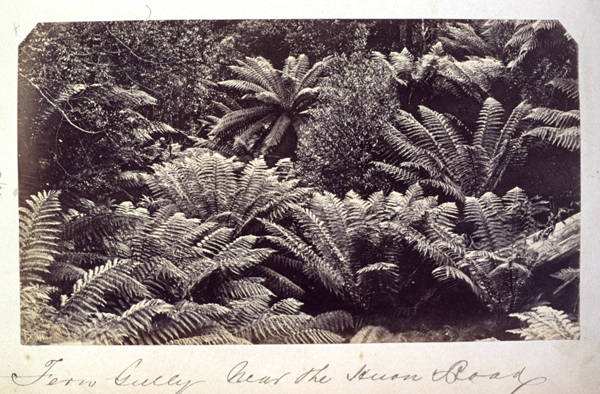 |
 |
|
Tree Ferns
Tree Ferns (Soft tree fern, Manfern, Dicksonia antarctica) form part of the under-storey of tall wet forests and rainforests in Tasmania; they can live for up to 250 years. An early reference to tree ferns in Tasmania comes in 1827 when Thomas Scott, merchant of Launceston, in a letter to Dr Hooker in Glasgow alludes to an 'extraordinary fern, (the fern Tree)'. By 1832, John Glover painted tree ferns on the foothills of Mount Wellington, while Baron von Hügel commented on their large fronds in 1834. Skinner Prout and others painted them in the 1840s, while Louisa Meredith described an enchantingly exquisite northern valley thus: 'we were in a world of fern-trees, some palm-like and of gigantic size'. Such references predate tree fern interest in Victoria. Piguenit used tree ferns to decorate his Salmon Ponds lithographs and work for the Cascade Brewery; by the latter half of the nineteenth century a whole micro-landscape using the fern tree theme at Fern Tree Bower, Mount Wellington had been created, captured well in a painting by AH Fullwood. Fern groves were favourite photographic subjects by many in the latter half of the nineteenth century. As fern fever mounted in Victorian England, in the 1860s and 1870s tree ferns became an exchange plant for the Royal Society's Garden, sent overseas in Wardian cases. They were used widely in the beautification of huts on Mount Wellington, for decoration of many civic important occasions and even today on the British market can fetch from £99 to £599 (about A$1500). Further reading: L Meredith, My home in Tasmania, London, 1852; T Burns & J Skemp, Van Diemen's Land correspondents, [Launceston], 1961; G Sheridan, 'A report on the significant trees in the Royal Tasmanian Gardens Hobart', unpublished report for RTBG, 2002; F Duncan, 'Spotlight on tree ferns', Forest Practices News 5/1, 2002. Gwenda Sheridan |
Copyright 2006, Centre for Tasmanian Historical Studies |
